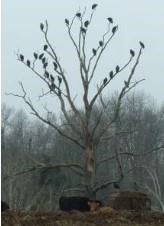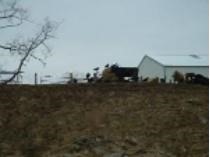By Richard Purdin
Spring has sprung and many producers have been able to get out and accomplish some field work the last few weeks as soil conditions firmed up and the grass begins to grow. Spring is a very busy time for many cattle producers, calving season is in full swing, and many producers are preparing on letting cattle out of the winter lots and in the pasture. It is a wonderful thing to see a newly born calf, lamb, kid, colt, or even pigs on the farm, it is a true sign of spring. On the other hand, spring can have a dark side and an ever-growing problem flying above many green pastures, creating one more challenge for livestock producers these days.

Black Vultures keeping a close eye on cattle
The Black Vulture has become more of an issue for livestock producers especially during birthing season where young livestock are born on open pastures. Black Vultures are very aggressive creatures that are considered scavengers but have a tendency to attack live animals especially young newborn livestock. Many producers have reported young calves being injured or even killed by Black Vultures. Injuries include eyes damage umbilical cord injuries and even as far as killing the young calf and cow during the birthing process!

In their search for food, black vultures fear little
Recently the Ohio Department of Natural Resources obtained a statewide depredation permit for black vultures through the U.S. Fish and Wildlife Service. Through a partnership between USDA wildlife services and Ohio department of Natural Resources, sub- permits can be issued to livestock producers experiencing issues with black vultures. Sub-permits will cover commercial livestock such as cattle, sheep, goats, swine, and horses. These sub-permits will be free to producers allowing them to remove up to five birds following all rules and regulations required by the U.S. Fish and Wildlife Service and Ohio Department of Natural Resources. Sub- permits applications can be obtained by contacting Thomas butler at Thomas.p.butler@usda.gov .
Here are some important facts and considerations before applying for a permit:
- Populations are growing– In the past 30 years Black Vulture populations have doubled in numbers and range areas has expand more northward. Black Vultures have been very known to adapt to changing environments and landscapes and have little fear of human activity. Once to be a sign of spring, black vultures would migrate father south but as winter climates have become warmer black vultures can be seen even in winter months.
- Black Vultures are angry birds! – Black vultures are known to be very aggressive compared to their red headed turkey vulture counterparts. Black Vultures have been known to attack live animals and kill young and older livestock. Turkey Vultures on the other hand are more scavenging type that primarily eat dead material such as roadkill and other dead species, this is why they are important for the environment.
- Black vultures don’t like to hang around their own dead- If producer receive a permit to kill Black vultures it is recommended to hand the dead birds up in effigy, this can be in a tree, on a fence post, or other structures that are visible.
- Remove their roosting site- Black Vultures like to roost in open branched/dead trees, older unused barns, and abandoned houses. If you have these on your farm removing them will help prevent Black Vulture from making a home on your farm.
- Don’t forget that these birds are protected species- As a producer myself I often think, why in the world would anyone protect this nuisance of a creature! The reality is that they are protected under the Migratory Bird Treaty Act, this means that they cannot be harmed without the use of a permit. Use of pyrotechnics, loud noises, flashing lights, lasers, and guard dogs or donkeys have seen some success. There have also been some signs that grazing management practices such as rotational grazing or intensive stock grazing can reduce animal injuries. The theory is that animals are kept in groups and protection is in numbers, eliminating pregnant females or babies to go off by their self away from the rest of the herd. Utilizing barns or calving lots close to farm head quarters can be helpful too, allowing producers to keep a closer eye on cattle during the calving season.
Source : osu.edu